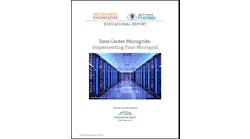Rhode Island may be a small state, but there is nothing diminutive about its grid modernization plan, which draws a big circle around what ails the electric grid and aims with bull’s-eye precision at the solutions.
Released last week, “Rhode Island Power Sector Transformation, Phase 1,” starts by tackling the core of what troubles New England states – expensive electricity.
The 90-page report then proceeds to show how distributed energy resources, microgrids, digital intelligence and other modern grid technologies can reduce costs – but only if allowed. That means replacing regulations that were developed for power technologies of 100 years ago.
“The state’s electric utility and regulatory framework were developed in an era in which demand for electricity consistently increased, technology changed incrementally, customers exerted little control over their electricity demand, electricity flowed one-way from the utility to customers, and the risks of climate change were unknown,” said the report, which was issued by Division of Public Utilities & Carriers (DPUC), Office of Energy Resources and the Public Utilities Commission.
None of these factors are true today.
Electricity costs to keep rising…
“Demand for electricity has plateaued; many customers generate their own power; electricity flows to and from customers; technologies are being introduced at rapid pace; and the need to mitigate and adapt to climate change is real,” said the report. “In these new circumstances, the traditional regulatory framework will not continue to serve the public interest.”
For one thing, electricity costs will keep rising unless something changes, according to the report. A federal database pegs Rhode Island’s average residential electricity rate at 18.08 cents/kWh, just below the New England average of 19.03 cents/kWh but well above the U.S. average of 12.91 cents/kWh.
As the Rhode Island report points out, a big part of the problem is that the electric grid is built for peak usage. Other industries have gotten capacity unevenness under control with information technology. Not so the power sector.
Half of utility investments not used most of the time
“Rhode Island’s peak to average demand ratio is 1.98, meaning that nearly half of the utility’s capital investment is not utilized most of the time,” the report said.
Over the last decade, the smallest state in the nation had over 1,200 MW of excess capacity in most hours. The top 10 percent of those hours cost the state $67 million, according to the report.
The problem is a longstanding one in the electric sector, and common in New England. Rhode Island wants to “right-size” the system.
Macky McCleary, Division of Public Utilities and Carriers
“New controllable distributed energy resources (DERs) paired with information technologies justify state policymakers to ask whether this long-standing inefficiency, is in fact, necessary,” said the grid modernization report.
Rhode Island pointed out other reasons to pursue grid modernization, as well, such as a growing desire for more energy choices by consumers and the greening of the grid.
To achieve these goals, the grid modernization plan recommends several concrete solutions, among them a change in the way utilities are compensated. Right now, the regulatory framework suffers from what the report calls “capital bias.” Utilities are rewarded for building centralized infrastructure, such as transmission lines. The report calls for a shift to performance-based incentives with rewards based on outcomes.
Macky McCleary, Rhode Island DPUC administrator, gave further insight into the grid modernization proposal November 7, when he participated on a panel at Microgrid 2017 in Boston.
“We do intend to essentially compensate for performance — performance defined across a wide range of metrics, including resiliency,” said McCleary, who spoke on the panel, “The Grid of the Future – A Regulatory Perspective.”
Microgrid 2017 sold out! Register for Microgrid 2018 today.
In reference to microgrids this might mean that “by a date certain you, system operator [utility], need to provide a certain level of load shifting, peak shaving and in some dedicated areas, locational incentives on the grid for things like distributed energy and microgrids — to enhance resiliency where the grid is weak,” McCleary said during an opening plenary session.
Will the microgrids then be owned and operated by the utility or a third party? Utility microgrid ownership is controversial in restructured states like Rhode Island, where utilities cannot own generation.
Under the grid modernization proposal, it depends on the situation, McCleary said.
“We have not said one or the other. But certainly, both are possible,” he said.
Consider RI as site of Amazon’s new headquarters
Consider the scenario of Rhode Island vying to be the location of Amazon’s next headquarters. The proposal includes a microgrid in downtown Providence “that could be owned by the utility. But it could be owned by Amazon. I think the important thing is we’ve created the possibility for compensation of that service,” he said.
Rhode Island’s grid modernization proposal opens the possibility of all components of the electric system being offered as a service, whether it’s hardware, meters or resiliency – all of which would offer the utility an alternative to today’s model of compensation.
“In the long term, we view the value proposition shifting to a world in which we are compensating for things that have concrete value as opposed to paying for electrons. That allows microgrid developers or microgrids themselves to participate as a platform service provider…and to both compensate the utility and ratepayer for access to that platform and be compensated for those services,” he said.
Grid modernization to spur innovation
Rhode Island also wants to provide incentive for the utility – in this case National Grid – to innovate. Current regulation discourages utilities from adopting new technologies because they often do not know if they will be allowed to recover costs until after the fact, according to the report.
“Rhode Islanders risk losing the opportunity to achieve innovation gains that have shaped other areas of our life by having a regulatory system that directs the utility to be overly cautious and avoids experimentation,” said the report.
To update electricity pricing regulation, the report makes several specific recommendations:
Create a multi-year utility rate plan and budget with a revenue cap to incent cost savings
- Shift to a pay-for-performance model by developing performance incentive mechanisms for system efficiency, distributed energy resources, and customer and network support
- Develop new value-streams from the distribution grid to generate third-party revenue and reduce the burden on ratepayers
- Update service quality metrics to address today’s priorities, including power outage prevention, cyber-resiliency and customer engagement
- Assess the existing split-treatment of capital and operating expenses
The report also delves into other grid modernization issues likely to affect microgrids, among them grid connectivity and advanced meters, distribution system planning and electrification principles — and again offers specific solutions.
The state had an admitted second-mover advantage in designing its grid modernization plan, kicked off just eight months ago. The state borrowed from the successes and mistakes made by the early grid modernization champions, like New York.
Rhode Island sees its grid modernization plan taking effect over the next three to five years with specifics being worked out among stakeholders in the various dockets, starting with National Grid’s upcoming rate case in December.
The report is available on the RI PUC website.







